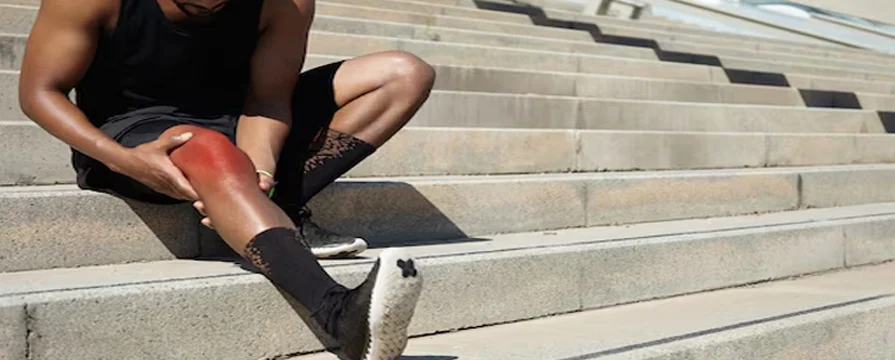People of all ages have knee discomfort which has a significant influence on their everyday life and general well-being. The complicated knee joint which carries a large portion of the body’s weight can develop a number of issues. There are many different reasons why people get knee pain which can cause severe agony and functional limits. These include both acute injuries like torn cartilage and burst ligaments as well as chronic disorders like arthritis and gout. Acute damage or gradual wear and tear can both cause knee pain which can significantly limit movement and make daily tasks more difficult.
Effective management and therapy of knee pain require an understanding of its underlying causes. Meniscal tears, sprains and strains are among the injuries that frequently need to be treated right once to stop further damage. Conversely long-term ailments such as gout, rheumatoid arthritis and osteoarthritis can progressively deteriorate joint function hence it is imperative to swiftly cure these disorders. Early treatment can reduce discomfort enhance joint function and help avoid long-term issues that could develop from illnesses left untreated.
While self-care techniques like rest, ice and over-the-counter drugs can help manage many cases of knee pain more extensive therapy may be required in others. For some pain type’s physical therapy and knee braces can be highly helpful in reducing discomfort speeding up healing, and improving joint stability. Surgical intervention can be necessary in more severe cases to repair damaged structures and restore proper function. Understanding the value of prompt treatment is essential to getting the greatest results and continuing to lead a fulfilling life in spite of knee pain.
What is knee pain?
Any soreness or discomfort in the area of the knee joint which joins the shin and thigh bones (femur and tibia) is referred to as knee pain. The knee being the biggest joint in the body experiences a great deal of strain and weight when moving, which increases the risk of injuries and illnesses. While knee discomfort can occasionally be a transient problem, it can also become chronic and need to be properly diagnosed and treated by a professional.
Here are the Different Types of Knee Pain
1. Injury
Traumatic incidents like auto accidents or sporting events frequently result in knee injuries. Sprains, meniscal tears and tears of the ligaments (such as ACL and PCL injuries) are common injuries. Depending on the damaged structure these injuries can cause localized or acute discomfort. For example ACL tears typically result from abrupt changes in direction or from landing incorrectly whereas PCL tears happen when the knee is struck from the front while bent. Symptoms include immediate pain and swelling which are frequently accompanied by knee stiffness. Several tissues may be impacted at once.
2. Overuse
Repetitive tension on the knee joint leads to overuse injuries, which eventually cause discomfort. In contrast to acute injuries overuse injuries occur gradually and are typified by discomfort that frequently gets worse when doing activities like sitting for long periods of time or ascending stairs. One common occurrence is chondromalacia sometimes known as runner’s knee which produces pain under the kneecap and at the front of the knee. Usually this kind of pain gets worse while you move and gets better when you relax.
3. Bursitis
The inflammation of bursa which are fluid-filled sacs that support and cushion the knee’s bones, tendons and muscles is known as bursitis. Excessive pressure on the knee, repetitive stress or injuries can all cause this problem. Localized discomfort swelling, warmth and redness around the knee are signs of bursitis. Pain can be experienced both when moving and when at rest and it can radiate to nearby regions, impairing knee function as a whole.
4. Tendinitis
The inflammation of the tendons that join muscles to bones is known as tendinitis. It may arise as a result of aging repetitive stress or severe injuries. Patellar tendonitis often known as jumper’s knee is a frequent type of the condition that causes pain around the patellar tendon when engaging in knee-extension exercises like jogging or jumping. When moving, tendinitis pain frequently gets worse. It can also cause stiffness which is especially obvious in the morning or after periods of inactivity.
5. Arthritis
Osteoarthritis and rheumatoid arthritis (RA) are prevalent disorders affecting the knee. Arthritis is a general term for inflammatory conditions affecting the joints. In osteoarthritis cartilage gradually deteriorates, causing pain, stiffness and decreased mobility that frequently gets worse with movement and becomes better with rest. Both knees are affected by RA, an inflammatory disease that causes joint inflammation and produces stiffness, edema and persistent discomfort. In contrast to osteoarthritis, RA usually affects the body symmetrically on both sides.
6. Infection
Bacterial or fungal pathogens can cause infections in the knee, including septic arthritis, which is characterized by extreme pain and inflammation. Severe pain, redness, warmth, limited mobility and fever are among the symptoms. Due to the substantial effects it may have on joint function and general health this illness needs to be treated very away. Localized knee pain is frequently accompanied by fever and systemic symptoms, indicating an urgent need for therapy to address the infection and prevent joint injury.
Conclusion
It is essential to comprehend the different kinds of knee pain in order to effectively manage tha knee care and cure it. Depending on the cause of the pain acute injuries, overuse, bursitis, tendinitis, arthritis or infections a different strategy is needed for each disease in order to reduce discomfort and return function. Individuals can continue to lead active, healthy lives by receiving early diagnosis and intervention which can also improve overall outcomes and stop symptoms from getting worse.
Taking proactive steps, such as getting medical advice, adhering to prescribed treatments and implementing preventive measures, can dramatically increase knee health. Through quick and thorough treatment, people can lessen the burden of knee pain on their everyday activities and lower their chance of developing long-term consequences.




